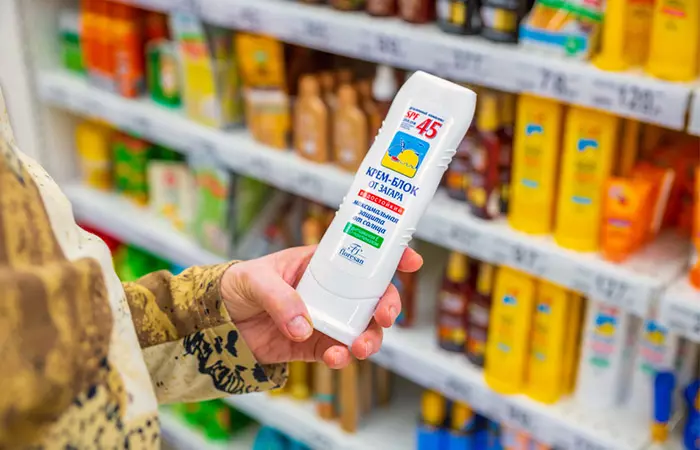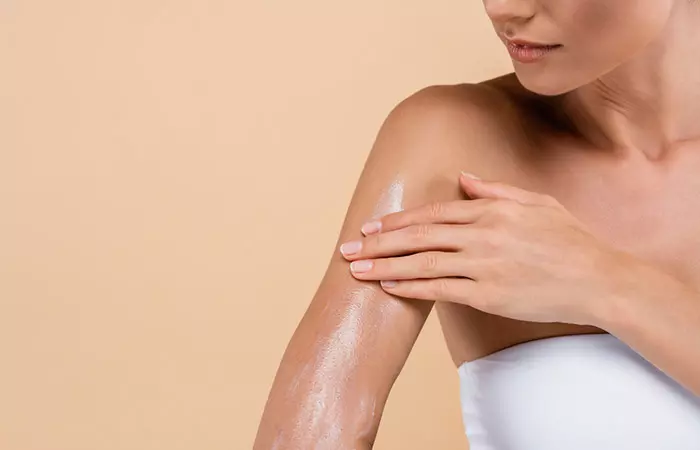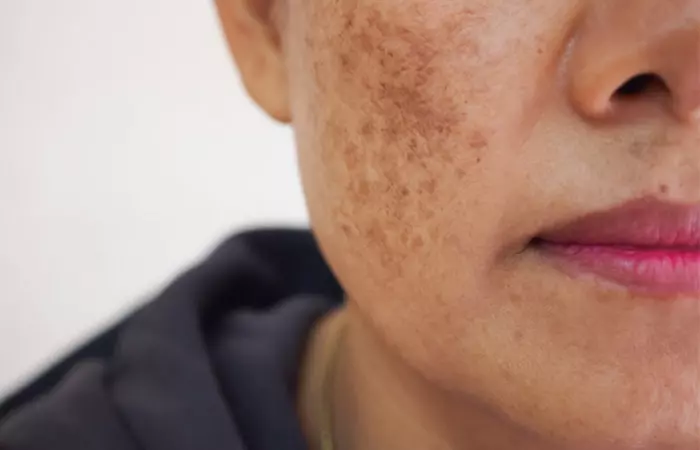However, before you strike off octinoxate containing products from your skin care routine, learn the truth behind this ingredient. Read on.
What Is Octinoxate?
Octinoxate or octyl methoxycinnamate (OMC) is a UV absorber. It appears like a clear, non-water-soluble liquid and is combined with other chemicals in sunscreen to prevent UV damage. It absorbs UV rays of a specific wavelength range, preventing them from penetrating the epidermis (1). Octinoxate combines methoxy cinnamic acid and 2-ethyl hexanol. These compounds are not harmful by themselves. In fact, octinoxate is used in the formulations of several lip balms, sunscreens, moisturizers, and other skin care products. UV damage is usually caused by the free radicals produced by oxidative stress. Free radicals, also called reactive oxygen species (ROS), can affect the body’s tissues and cells and may cause photodamage, which includes dark spots, wrinkles, hyperpigmentation, and even skin cancer (2). Chemical UV filters like octinoxate in sunscreen help avert such damage. Chemical filters are different from mineral UV filters (zinc oxide and titanium dioxide), which sit on the skin and block the UV rays. To locate octinoxate in your sunscreen products, you can scan the ingredient list and check for:
OMC Ethylhexyl methoxycinnamate Parsol and Parsol MCX Escalol 2-Ethylhexyl p-methoxycinnamate Octyl methoxycinnamate
Is Octinoxate Safe As A Sunscreen Ingredient?
There is not enough empirical evidence to mark octinoxate as a safe or unsafe ingredient. The FDA restricts its strength to a maximum of 7.5 % in skin care products (4). Other countries like Canada, Japan, and the European Union also allow the usage of octinoxate in sunscreens but have capped the maximum concentration at which this chemical can be used in these products. On a scale of 1-10 (10 being the most harmful), the Environmental Working Group gives octinoxate a 5 rating, as it may cause (5):
moderate endocrine disruption non-reproductive organ system toxicity (low) biochemical or cellular level changes (high)
Hawaii has banned the sales of any sunscreen and product containing octinoxate and oxybenzone, as these ingredients are not reef-safe and have other environmental repercussions (6). A survey was conducted on 1325 participants and found that 75% of participants were aware of the side effects of sunscreen with harmful chemicals that were not reef-safe. However, approximately one-third still used sunscreens with octinoxate and more than 50% of respondents purchased their sunscreen in Hawaii, meaning that the chemical ban would substantially affect the purchase of sunscreens. Octinoxate may also affect neurological and reproductive development. A study on pregnant Wistar rats found that octyl methoxycinnamate affected reproductive and neurological systems in rat offspring (7). While scientists are not sure if octinoxate will have the same effect on humans, it is definitely a cause for concern. Brittany, a blogger, reflects on her experience with cosmetics while navigating pregnancy: “My doctor assured me that sunscreens are safe, but for now I think a sunscreen with zinc and/or titanium dioxide is the safest way to go (i).” She expresses concern about octinoxate as it’s not recommended for pregnant women. A study detected trace amounts of octinoxate in urine and concluded that it penetrates the human skin (8). On the flip side, some studies have concluded that even if the chemicals pass through the skin, their levels are too low to cause toxicity (9). While studies remain inconclusive on octinoxate’s impact on human skin and health, you will find it in various products. Despite some looming concerns over the safety of using octinoxate in skin care products, all the big cosmetic and beauty brands are using it. This is due to the skin benefits that octinoxate offers.
Benefits Of Octinoxate
1. Protects The Skin From Harmful UV Rays
The primary function of octinoxate is to filter out harmful UV rays and prevent photodamage and photoaging. It can:
Prevent sunburn Reduce the risk of skin cancer Reduce the risk of premature aging Prevent collagen degradation (caused by free radicals)
2. Gives A Thin Consistency To Formulation
Most of us think of sunscreens as being thick, sticky, and not easy to spread (leaving the infamous white ghost-like cast). However, sunscreens with octinoxate usually have a light texture, consistency, and flow, making the product easy to apply.
3. No White Cast
Usually, mineral sunscreens and products with a mix of physical and chemical filters leave a white cast on the skin. However, using octinoxate in sunscreens has minimal chances of leaving a white cast on the skin. Wondering whether you should use or avoid sunscreens and skin products containing octinoxate? Check out the next section.
Who Should Avoid Using Products With Octinoxate
Anyone can use products with octinoxate. However, avoid them if you:
Have melasma (it needs the best UV protection, so chemical filters like OMC are preferable)
Have sensitive skin Have acne-prone skin (chemicals may aggravate the lesions) Are pregnant or lactating (as its effects are still unclear) Have skin conditions like psoriasisi A rash with itchy, scaly patches found on the back of the knees, elbows, and scalp that is triggered by an infection or stress. , eczemai A skin condition that causes dryness and itchiness at the back of the knees or arms due to a reaction to irritants or allergens. , and dermatitis Are allergic to chemical filters
While it’s important to use sunscreen every day to protect your skin from sun damage, it’s also important to be wary of their composition. Most sunscreen side effects, such as allergic reaction, acne, etc. are observed due to certain chemicals and filters in them. So, knowing which UV filters suit your skin and which to avoid helps. Does octinoxate cause aging? Octinoxate may cause aging as it has been shown to generate free radicals in the skin when exposed to UV rays (10). However, regular re-application of sunscreen may reduce the number of free radicals formed by chemical sunscreens. Is octinoxate organic? No. Organic ingredients are generally derived from plant or animal sources, and octinoxate is a chemically synthesized compound. Nevertheless, it is approved by regulatory agencies to be used in several skin care products. Octinoxate, a chemical found in many cosmetics, can be bad for us. It can cause reproductive toxicity, neurotoxicity, endocrine or hormonal disruption, and allergies. Learn more about it in this video. editorial policy











